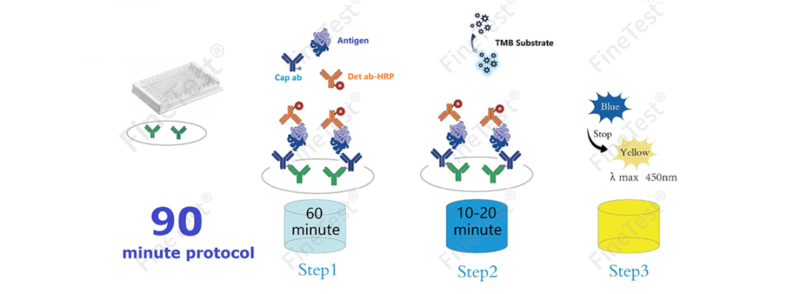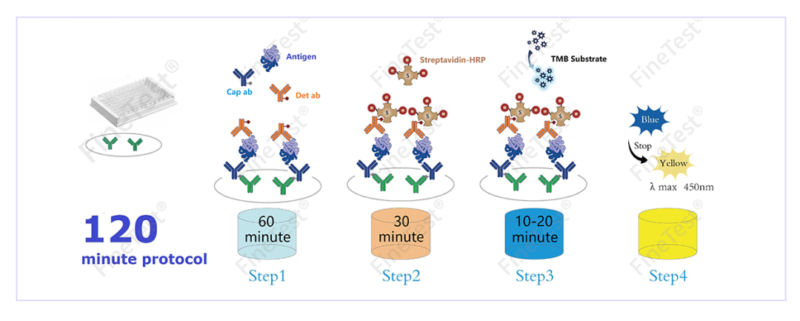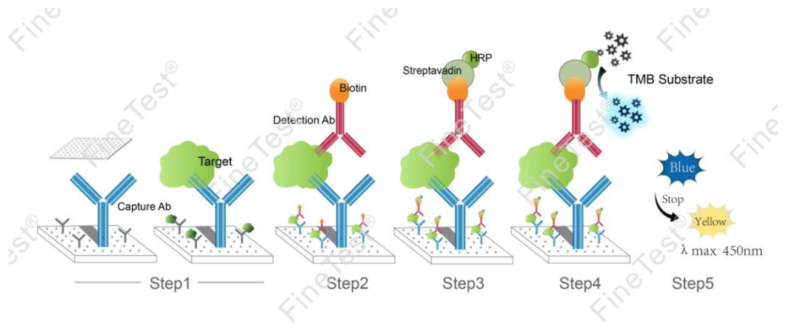Abstract: Enzyme-linked immunosorbent assay(ELISA) was first found in 1971. ELISA performs the qualitative or quantitative analysis for trace substances in the sample. First, fix antigen or antibody on solid phase carrier(e.g. polystyrene well). Then, add enzyme-labeled antibody or antigen with high specificity. Wash off unbound components. Finally, add TMB substrate solution and observe the staining reaction. Comparison for three ELISA method steps is specified below.
Keywords: ELISA Method Steps, Enzyme-linked immunosorbent assay(ELISA), ELISA Kit Principle
1. Types of ELISA Method Steps
ELISA methods include direct, indirect, sandwich and competitive ELISA, suitable for different molecules. Experimental duration is about 3-6h. Duration of direct ELISA is shorter than sandwich and indirect ELISA. FineTest develops one and two step ELISA based on sandwich detection, significantly improving efficiency via operation optimization.
2. Principle of One Step ELISA Kit
FineTest QuickTest ELISA Kits simplify traditional steps. Capture antibodies carry affinity tags. The microplate precoated the antibody which can recognize this tag. Add Cap/Det Ab working solution and samples or standards into wells. If the target factor is found, only one step can form capture antibody-target factor-biotin-detection antibody complex in the well. After washing, add TMB substrates to visualize HRP enzymatic reaction. HRP catalyzed-TMB produces a blue color product that turned yellow after adding a stop solution. Read the O.D. absorbance at 450nm in a microplate reader. The concentration of the target substance is proportional to the OD450 value. Quantitative analysis is performed via plotting standard curve.

ELISA Assay Steps:
❶ Take the required strips. Add 50 µl Cap/Det Ab working solution. Then, add 50 µl standards or samples. Seal the plate and gently shake for 10s. Incubate for 60min at 37℃(load samples via changing tips and gently touching the liquid level). Wash five times without immersion.
❷ Add 90 µl TMB substrates and seal the plate. Incubate for 10-20min at 37℃.
❸ Add 50 µl stop solution. Then, immediately measure OD450 and calculate the result.
3. Principle of Two Step ELISA Kit
Unlike one step, biotin is used to label antibodies. Capture antibodies carry affinity tags. The microplate precoated the antibody which can recognize this tag. Add Cap/Det Ab working solution and samples or standards into wells. Incubation forms capture antibody-target factor-biotin-detection antibody complex. After washing, add HRP-Streptavidin to incubate again. Repeat washing and add TMB substrates to visualize HRP enzymatic reaction. Then, stop the reaction to read the O.D. absorbance at 450nm. Concentration of the target substance is proportional to the OD450 value. Quantitative analysis is performed via plotting standard curve.

ELISA Assay Steps:
❶ Add 50 µl Cap/Det Ab working solution. Then, add 50 µl standards or samples. Gently shake for 10s. Incubate for 60min at 37℃. Wash twice.
❷ Add 100 µl HRP-Streptavidin. Incubate for 30min at 37℃. Wash five times.
❸ Add 90 µl TMB substrates. Incubate for 10-20min at 37℃.
❹ Add 50 µl stop solution. Read the O.D. absorbance at 450nm and calculate the result.
4. Principle of Three Step ELISA Kit
Three steps in sandwich ELISA first fix the capture antibody on solid phase carrier. After the binding of target substance with capture antibody, wash unbound components and then add biotin-labeled detection antibody. Biotin binds with Streptavidin. Streptavidin binds with enzymes(e.g. HRP) to form enzyme-labeled complex. After washing off unbound components, add TMB substrates to visualize HRP enzymatic reaction. Finally, calculate the concentration of target substance via measuring OD value. Biotin labeling improves the sensitivity and specificity of detection.

ELISA Assay Steps:
❶ Add 100 µl standard or sample. Seal the plate and incubate for 90min at 37℃. Wash twice.
❷ Add 100 µl biotin-antibody working solution. Seal the plate and incubate for 60min at 37℃. Wash three times and immerse for 1min each time.
❸ Add 100 µl HRP-Streptavidin Conjugate(SABC) working solution. Seal the plate and incubate for 30min at 37℃. Wash five times and immerse for 1min each time.
❹ Add 90 µl TMB substrates. Incubate for 10-20min at 37℃.
❺ Add 50 µl stop solution. Read the O.D. absorbance at 450nm in a microplate reader and calculate.
5. Advantages Comparison of Different ELISA Kits
FineTest QuickTest ELISA Kits can form capture antibody-target factor--HRP-detection antibody complex with only one step. Optimization of ELISA assay includes time-saving and reduced operation errors. Compared with common ELISA Kits, linearity, stability and recovery are higher. The optimized wash buffer also improves experimental efficiency.
| Category | Common ELISA Kit | 90min Rapid Assay | 120min Rapid Assay | Advantage Analysis |
|---|---|---|---|---|
| Reaction Duration | 4h | 90min | 120min | a great decrease of assay time |
| Washing Times | 10 | 5 | 7 | Less washing, easy operation |
| Washing Immersion | Y | N | N | Faster washing without waiting |
| Dilution of Detection Reagents | Concentrated, Dilution Required | Ready-to-Use without dilution | Ready-to-Use without dilution | Avoid improper reagent preparation |
| Distinguished Reagent Colour | N | coloured | coloured | Avoid missing and mistaking in sample loading, improve loading efficiency |
| Precision | CV<8% | CV<6% | CV<6% | Lower CV, Higher Precision |
| Numbers of Reagents | 9 | 6 | 7 | Less Reagents |
QuickTest ELISA Kits are widely applied in clinical diagnosis(e.g. detection for disease markers, antigens and antibodies; evaluation for immune response and inflammation; effects of drugs on proteins etc.), scientific research, food safety, environmental monitoring and forensic medicine. The key detection with high sensitivity and specificity is designed for specific molecule in biological samples.
6. Recommended Products
| Cat.No | Product Name |
| QT-EH0027 | Human ACE2 QuickTest ELISA Kit |
| QT-EH2593 | Human ADP QuickTest ELISA Kit |
| QT-EH20018 | Human CRP QuickTest ELISA Kit |
| QT-EH0164 | Human IFN-γ QuickTest ELISA Kit |
| QT-EH0185 | Human IL-1β QuickTest ELISA Kit |
| QT-EH0201 | Human IL-6 QuickTest ELISA Kit |
| QT-EH3267 | Human IL-17A QuickTest ELISA Kit |
| QT-EH0222 | Human MCP-1 QuickTest ELISA Kit |
| QT-EH0238 | Human MMP-9 QuickTest ELISA Kit |
| QT-EH4007 | Human PEA QuickTest ELISA Kit |
| QT-EH0287 | Human TGF-β1 QuickTest ELISA Kit |
| QT-EM0109 | Mouse IL-1β QuickTest ELISA Kit |
| QT-EM0112 | Mouse IL-2 QuickTest ELISA Kit |
| QT-EM0121 | Mouse IL-6 QuickTest ELISA Kit |
| QT-EM1592 | Mouse CXCL15 QuickTest ELISA Kit |
| QT-EM0205 | Mouse VEGF QuickTest ELISA Kit |
| QT-EMK0189 | Monkey TSH QuickTest ELISA Kit |
| QT-ER1393 | Rat TNF-α QuickTest ELISA Kit |
REFERENCES
[1]Development of aptamer-based ELISA method for d-dimer detection, PMID: 35426180.
[2]Development and validation of ELISA method for quantification of Q-1802 in serum and its application to pharmacokinetic study in ICR Mouse, PMID: 38636191.
